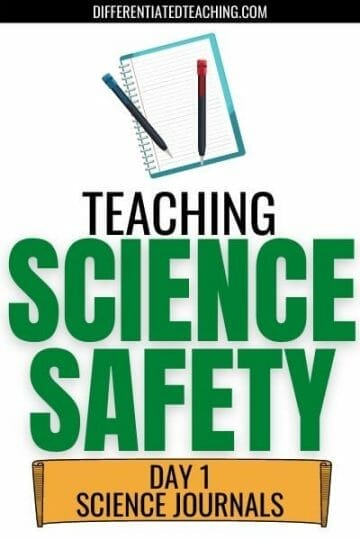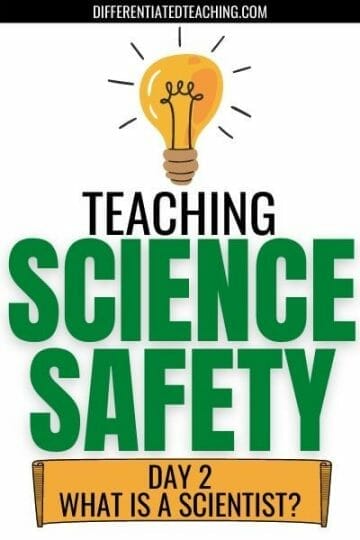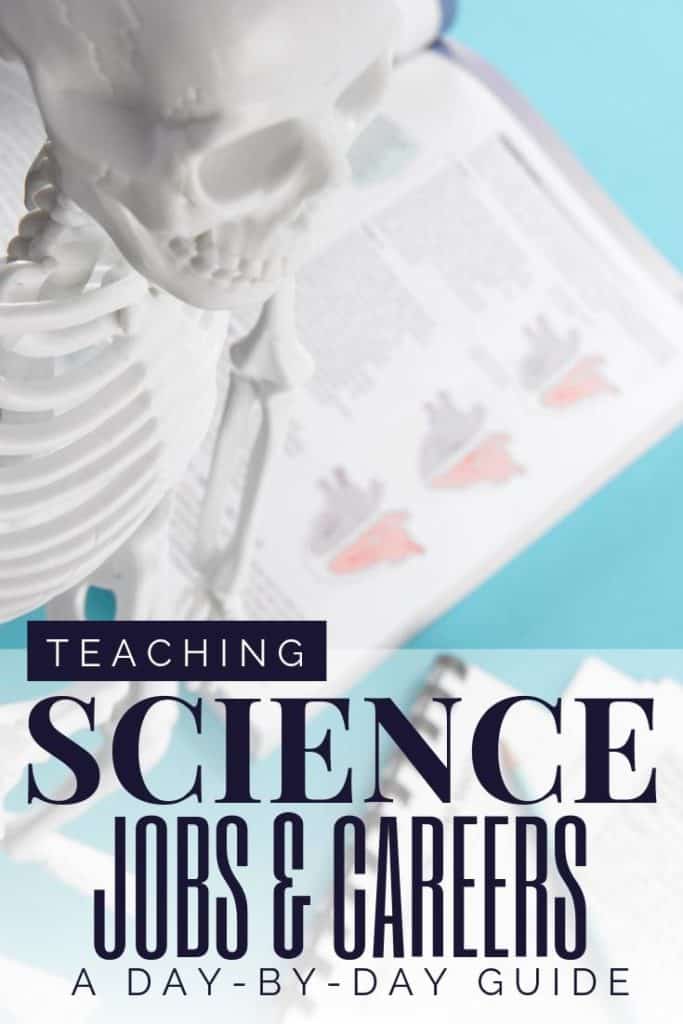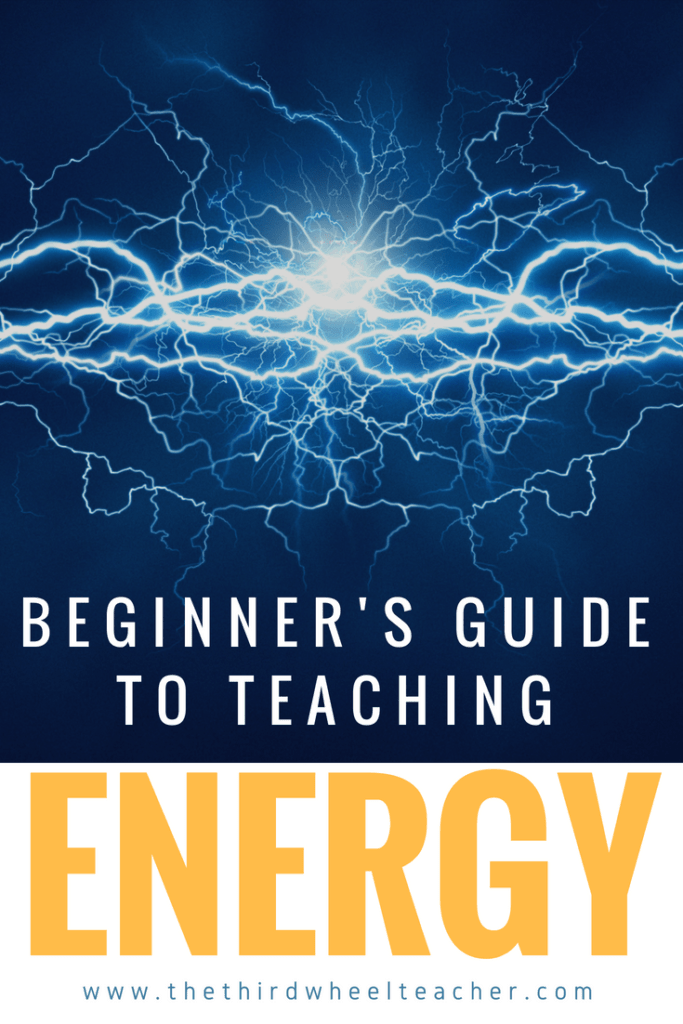Science Safety & Tools: Teaching Science in the Elementary School
Science safety is something that students must learn, and it’s an important part of teaching science in the elementary school. However, science safety and tools can feel like a boring way to start each year.
The good news is – It doesn’t have to be! I’ve outlined these lesson plans for science safety and tools that will keep your students engaged and excited to learn about these core pieces of any science curriculum.

Introducing Science Safety & Tools: Lessons for the Elementary Science Classroom
In our curriculum, we are given about a week to introduce students to science safety and methods. This includes introducing them to lab procedures and discussing the scientific method.
Overall this isn’t an issue for most elementary learners because they aren’t working with many harmful materials, but it could definitely be extended if you’re planning some experiments that warrant a better understanding.
Here’s a general outline of the lesson plans we’ll cover during our week:

As you can see, I also use this time to help us set up our science journal for the year so that we’re all set to go from here. After that, we jump right in. Now that you’ve got an overview. Let’s dive into the day-by-day plan.
Lesson Plan for Day 1: Set Up Student Science Journals
No matter what grade you teach, the first thing I do when teaching science in the elementary school grades is to set up science journals because it sets the stage for the rest of the year. Our entire campus utilizes journals so it doesn’t take a ton of explanation besides the little individualized stylings that I use in my room.
My science journal is divided into three sections:
- lesson notes
- experiments & labs
- science vocabulary
Each section is reserved for specific information so that students can quickly and easily find what they need throughout the year.
Lesson notes are all the notes we take during our instruction. This will include drawing diagrams and labeling them during our matter unit, and we will actually begin using this during our science tools study.
Experiments and labs is the section where students write their lab notes. They record the scientific question we are trying to answer. Their materials, hypothesis, and the details of the scientific method. This is an important part of teaching science in the elementary school because it sets them up to be successful later.
Finally, the vocabulary section is where students record the Tier 3 content vocabulary we learn in science. Since academic vocabulary is such an important part of success in school, I like devoting an entire part of our notebook just to this.
Quick Tips for Teaching Science to Elementary: Pre-print tabs or create an easy way for students to mark the sections of their journal to save time throughout the year.
Lesson Plan for Day 2: We are scientists
I love this lesson….really, seriously love it! I read it on a chat board years ago, which I cannot seem to locate (if this is your lesson, let me know so I can give you credit!).
It works so perfectly to connect the rest of the week, and it is super simple. All you need are envelopes with a small hand mirror in each, and it really stick with the kids. The day begins with the question, “What is a scientist?”
I elaborate by adding what do they look like, what might they wear, where would I find them. I try to really get them to think deeply about their preconceived notions.
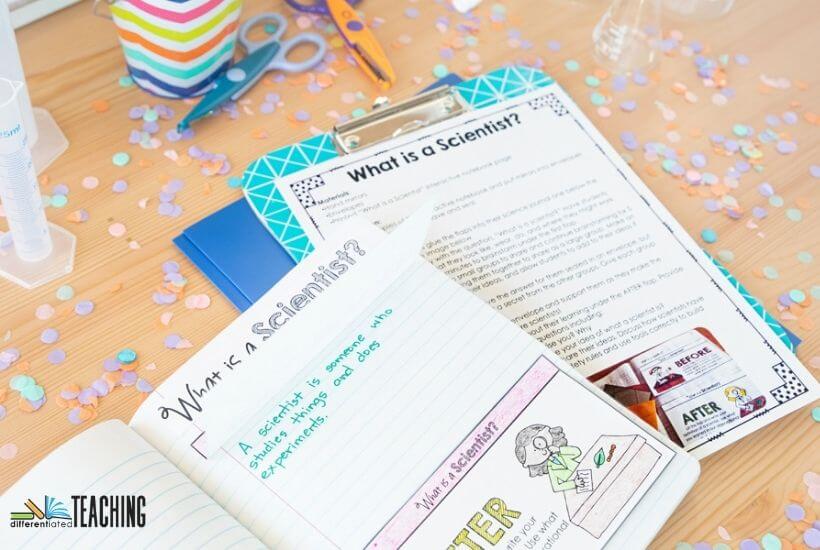
After my students brainstorm independently for about 3-5 minutes under their top flap, I put them into small groups to share for another 5 minutes or so.
Finally, I bring them together to share what they wrote.
I create a class list either on a board or on chart paper to track their answers. They can add to their flap if something strikes them. After we do this, I tell them I have the complete full answer sealed in an envelope for each group.
I let them know they will get to see this answer, but they’ll need to keep it a secret from the other groups. Then I hand each group an envelope.
When the kids first open their “answer”, I often get a lot of confused looks. They check the back of the mirror and the sides, and sometimes even need guidance to get to the idea of looking into the mirror.
However, at least one student in each group ends up making the connection and the word quickly spreads. WE ARE SCIENTISTS!
I wrap up the lesson by having students reflect on this new understanding under the after flap.
I provide some guiding questions to help them write this second flap.
They need to tell me how their idea of what a scientist is changed because of this activity and whether the answer surprised them.
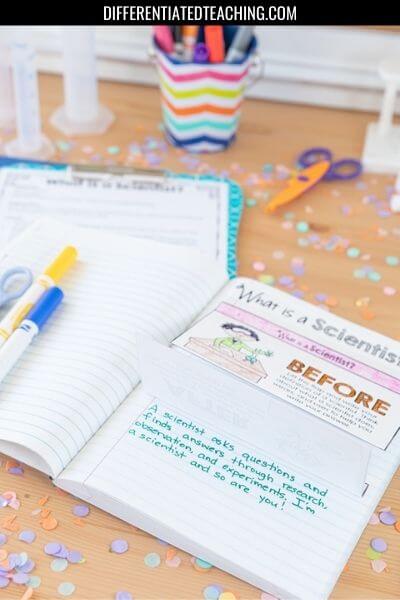
I conclude the lesson by giving a few students a chance to share out. Then I let them know as scientists we have certain responsibilities to follow science safety rules, follow the scientific method, and use tools correctly.
This becomes the focus for the rest of our week!
Lesson Plan for Day 3: Science Safety
I begin by connecting with yesterday’s lesson that we are all scientists in our class and reminding them that, as scientists, we are required to follow science safety rules.
Depending on my class, I use one of two videos. However, the second is no longer easily accessible in the US, so here’s the best option.

Then my class cuts and glues this easy foldable into their journal, and we sort and record the science safety rules by sense.
I feel like using the senses is a really approachable way to address safety rules, and my kids seem to really pick up on the point this way. We discuss each one as we go and why it is a rule.
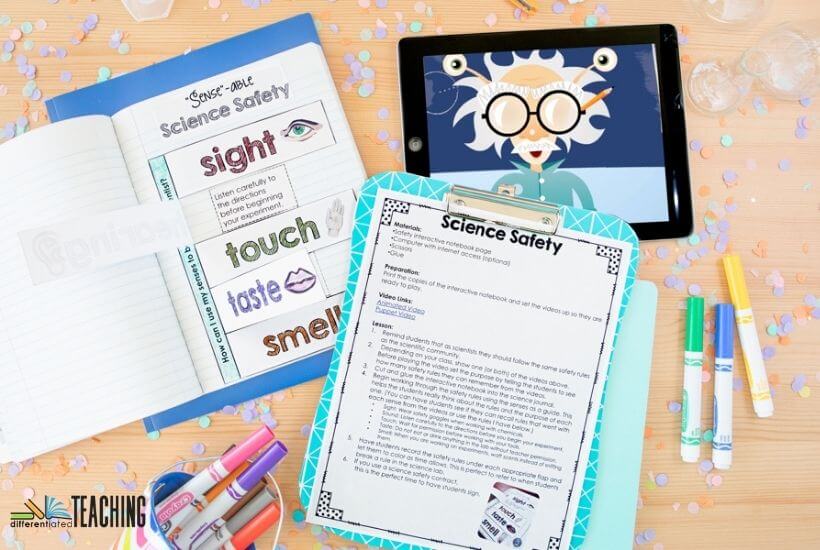
Finally, my students are ready to sign their safety contract, and they glue it to the front cover of their journal. I use this as a reminder when I see students not obeying lab safety rules.
If time allows, I also have a printable that is an illustration of a science lab with lots of safety violations.
Their job is to find and color ONLY the things that are not ok in the lab.
Many years I never get to this though because we are having such a great conversation about the safety rules and why they are in place.
Lesson Plan for Days 4-5: Science Tools
Science tools, especially their formal names, seem to be a challenge for many students. I have created a few stations that the kids will complete to get better acquainted with the main tools and how they work.
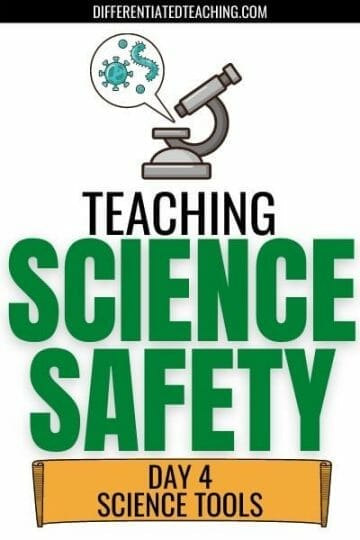
I tried to make the centers interactive and provide scaffolds to help my struggling learners. I find that this is one of the most important tips that I can share for teaching science at the elementary level.
The more you can differentiate and offer supports to help your learners be successful, the easier it will be for them as they start to catch up in math or reading because they won’t have as many gaps in these other areas.
Here’s a look at one of the activities in the centers.
This is a science tool matching game where students are challenged to match the name of the tool with its picture. However, many of these are tools younger scientists (like those in upper elementary) may not have used regularly. Therefore, each vocabulary card has a math problem on it and the picture cards have a number. Students can check their work by making sure the picture card contains the correct solution to the problem on the vocab card.
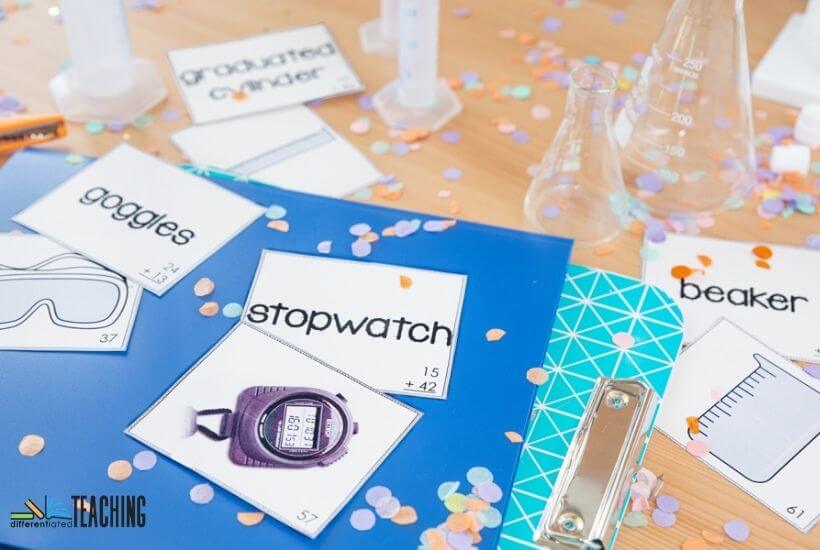
A second activity is a Science Tools Foldable designed to explore how each of the tools are used in the science lab. This time students need to be able to describe the function of each of the lab tools. Students cut and glue these into their lab journal and get to explore the uses of the real tool before completing each flap.
By the time we wrap up the week, the even my struggling learners are typically pretty confident in their understanding of the science safety rules and tools. From there we can move into science careers and then into our study of matter.
Are you teaching science in the elementary school and want to use these materials in your classroom?
I love supporting teachers with tips for teaching science to elementary students. One of the most important things I try to do is keep science fun, hands-on, and engaging for all my learners.
If you enjoyed this unit and would like to save yourself some time, grab the pre-written lesson plans, activities, and printables right now in my shop. You’ll find everything you saw in this blog post and a few extra surprises.
Find more great tips for teaching science to elementary students in these articles:
What’s your favorite lesson plan for science to teach? Let me know in the comments below!

